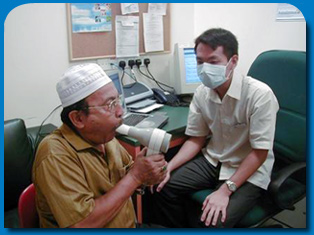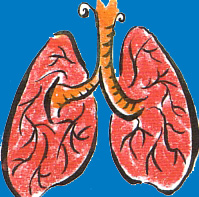 |
Spirometry - an important test for the diagnosis of COPD
Spirometry - can help your doctor confirm whether you have COPD as well as assess how severe is the condition.
According to international guidelines on the management of COPD GOLD, spirometry is the "gold standard" for the diagnosis of the condition and any person suspected to have COPD should undergo a spirometry test to confirm that he or she is indeed suffering from COPD.
Spirometry measures the ratio of the forced expiratory volume in the first second to the forced vital capacity (FEV1/FVC) and this measurement is the most sensitive and specific test for detecting obstruction of airflow in the lungs [ "What is COPD?" ]. The confirmation of airway obstruction in a patient with significant history of exposure to cigarette smoke or pollution helps the doctor to confirm the diagnosis and assess the severity of the condition. Using spirometry, COPD can also be easily detected in its preclinical phase, ie before symptoms of the illness (such as cough or breathlessness) arise in a smoker or ex-smoker.
Spirometry can also help doctors differentiate COPD from other lung disorders. In a presentation on 7th September 2004 at the European Respiratory Society 14th Annual Congress, Dr David Price, University of Aberdeen, Scotland, discussed the findings of a joint UK-US study that looked at almost 600 patients with COPD who were not diagnosed correctly by their physicians. One of the main findings of that study is that COPD is frequently misdiagnosed as asthma or another lung condition, with the result that patients received unnecessary or ineffective treatment, with poor outcomes. A significant part of the problem stems from the underuse of spirometry, Dr Price said. "It is a disaster of equal magnitude for a patient to be incorrectly diagnosed with asthma when he or she has COPD, or not to be diagnosed at all," he said.

What is spirometry?
Spirometry is a basic test of pulmonary (lung) function. Pulmonary function tests are used to detect lung diseases or to monitor the progression of a particular disease, such as COPD. Regular testing can detect lung disease in its early stages and allow for timely treatment. The most common pulmonary function test is done with a machine called a Spirometer [see photo above]. Spirometry testing is quick, non-invasive and painless. If you regularly experience breathlessness, have difficulty breathing, or otherwise suspect you have a lung disease, the COPD Association encourages you to ask your doctor for spirometry testing.
Spirometry is performed under various conditions with the patient breathing into a tube attached to the machine, which calculates the amount of air the lungs can hold and the rate that air can be inhaled and exhaled. The results of the test are compared with those of healthy individuals of similar height and age, and of the same sex and race.
Abnormal results may be a sign of lung disease (e.g COPD, asthma). If you have already been diagnosed with a lung disease before the test, the result will help your doctor determine how severe the disease is and/or the effectiveness of the treatment.
 Preparation for a Pulmonary Function Test
Preparation for a Pulmonary Function Test Up to 24 hours before the schedule test:
. Follow your doctor's orders to stop taking some or all of your medication
. Get a good night's sleep as tiredness can affect the accuracy of the test
Up to eight hours before the schedule test:
. Do not smoke or eat a heavy meal
Up to four hours before the test:
. Do not carry out strenuous activity. Wear loose, non-restrictive clothes that keep your chest area as free as possible when u come for the test.
During the test:
. The test is painless. Remain calm because fear or anxiety can make the test results less reliable.
How is a spirometry onducted ?
1. Basic information about yourself (height, weight, age and sex) will be recorded.
2. You will have to breathe into a Spirometer - a machine that measures how much air you are able to breathe in and out.
. Several breathing tasks may be required, such as :
- Taking in a deep breath, holding the breath and breathing out as forcefully as possible.
- Breathing rapidly into the tube.
. Follow instructions carefully. You may have to repeat the same task a few times to ensure consistent results.
. You will be given time to rest in between tasks.
3. The entire test takes approximately 20 to 45 minutes
4. You may feel light-headed because of the deep breathing you have been doing. You should remain seated until the feeling passes.
5. Occasionally, the doctor may request for an inhalation challenge test, which requires breathing in a solution to be conducted with the above tests.
What happens after the Test
The doctor will have a report of your test results. He/she will review these results with you. A number of different terms will arise during the discussion:
- Predicted values are the normal results that your doctor would expect for people with the same height, weight, age and sex as you.
- Measured values are your results in comparison with normal or predicted values. For example, if you only blow out half the amount of air that would normally be predicted, the measured value of your vital capacity (VC) would be 50 percent. If your total lung capacity (TLC) is exactly what would be predicted, the measured value is 100 percent.
The Association's recommendation
By the time most patients are diagnosed to have COPD, they may have lost at least 50% of their pulmonary function. That's why the Association, in cooperation with other international agencies such as GOLD and the National Lung Health Education Programme strongly encourage smokers, especially those with symptoms such as persistent cough and/or breathlessness to undergo spirometry testing.
Spirometry is currently available in certain polyclinics and general practice (GP) clinics. A recent study of spirometry conducted among smokers with no known record of any lung problems attending the National Healthcare Group polyclinics showed that more than 20% of them are detected to have varying degrees of obstruction in their airways . The association plans to make standard spirometry testing available at more GP clinics in future so that more people at risk of COPD [see diagnosis] can undergo the tests at a convenient location and so that family doctors can diagnose the illness at an earlier stage and institute appropriate treatment before complications such as respiratory failure occurs.
 |